An Interview With Legendary Trapper Bud Jenkins of Virginia
By: Bill Falkowski
Over the years as we’ve interviewed trapping legends from one side of the country to the other, I must admit my criteria of what makes a person a legendary trapper has changed. Of course everyone knows that high animal numbers really get people to look and listen and yes, it does sell product. Keeping in mind that being a good trapper is important, it’s not the only thing that makes a trapper legendary. The interview you have before you has one quality that in my mind is key to making a trapper reach legendary status and that is grit.
This interview was a special one for me. The opportunity to interview Bud Jenkins is one I won’t soon 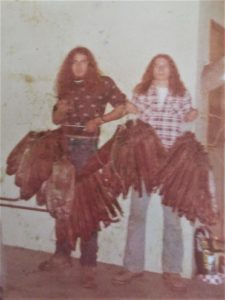 forget. You want grit, well, you got it. This interview is chock full of pictures and covers the higlights of one of the toughest guys I’ve ever met. Bud and I share a common bond, making us brothers if you will. Brother Bud, this one is for you. Hold on to your boot straps folks, it’s time to cover another legend!
forget. You want grit, well, you got it. This interview is chock full of pictures and covers the higlights of one of the toughest guys I’ve ever met. Bud and I share a common bond, making us brothers if you will. Brother Bud, this one is for you. Hold on to your boot straps folks, it’s time to cover another legend!
1. Bud, what year did you start your trapping career and in what state were you living?
It was around 1965 when I started trapping and I was living in Virginia. I’ve lived in Virginia my whole life except for the extended vacations I took to the Floriday Keys to commercial fish.
2. When you started trapping did you start like everyone else with muskrats and skunks?
I was nine years old in 65 and yes, I targeted muskrats for the first few years. There was alot of farmland that had swamps on it. Back then it seemed like a lot of kids did it, but we never had alot of competition.
3. When you were a youngster, what was your favorite animal to trap and has that animal changed over the years?
As a kid I loved to trap muskrats just because they were so numerous and available. Nowadays, my favorite animals to trap are otter, bobcat, and coyotes.
4. Growing up Bud, who were some of your trapping mentors?
To be truthful, I really didn’t have any the first few years coming up. I had a couple of friends whose dad’s owned coon hounds and hunted them, and that’s how I learned about market for muskrats. It was a lot of trial and error on muskrats back then, and I have to say there were alot of three-legged muskrats walking around back in them early years.
5. Were you a self-taught trapper or did you have a teacher such as an older friend or sibling?
I had one uncle on my dads side that was a trapper in his teens. He never showed me anything as far as trapping went because by the time I got into it, he had been out of the trapping scene for years. I taught myself everything I know about trapping. After I got a car when I was sixteen or seventeen, I started going after more complex species like beaver, otter, and cats. With a car I could cover so much more ground.
6. Were you ever married and do you have any children?
I was married once. I have a daughter who is 31 and son who is 27.
7. I’ve heard you’re a beaver and otter man. Where did you learn how to trap these two animals?
That again was alot of trial and error but I had a buddy by the name of Duane Combs who was the past president of NTA and we went out and bought some how-to books and just started trapping. Over the years I developed my own style and found out what works and what doesn’t work.
8. What’s your biggest day as far as beaver numbers go?
My biggest single day catch on beaver is 35 and for a season, just shy of 300. I used to put up all my own fur, but when the otter market came on, I just couldn’t keep up. I would skin all my beaver, sell them frozen, and I would put up all my otter because that’s where the money was. Top shelf otter were bringing $135.00 apiece back then.
9. What’s your biggest day as far as otter numbers go?
My biggest single day catch on otter was 15. My biggest season for otter was 111 of them. Out here in Virginia, there’s no limit on otter or beaver. Out here where I live, they hunt deer with hounds, so the first half of the season is impractical. All these catches I’m talking to you about were made in the months of January and February which is half of a normal season.
10. I know you’re a longliner Bud, what year did you start and are you still a longliner?
I would say I started longlining as soon as I had the first automobile available to me, so I was very young when I started longlining, whether it was for muskrats, beaver, otter, or cats, I was covering ground. I don’t know if you know how our season works, but I do work for the live market. Out here the only thing we can legally take in live traps are red and gray fox. I have several pen permits, and I will trap up until deer season and then pull everything until deer season has run its course which is usually the first week in January. By then all of our water animals are prime and I can get it in and start trapping them.
11. Tell us about your live market trapping experience.
I live trap a fair amount of red and gray fox, and some of the farms that these fox go to are 1000 acres or more. There are restrictions by the game commision as to how many fox per acre there can be, and there has to be hound proof escape huts for the foxes to get into. These farms are actually huge training facilities for hounds. It’s pretty big business. There are some serious field trials that go on in these places.
12. I was talking to Newt Sterling the other day, and he said I have to ask you about the funny story involving you and your good friend Belin Watson?
Well there’s a ton of em’, but I’ll give you one of the best ones. We were live trapping together, and this is when the live market just got started so there wasn’t a lot of regulations. One of the big hound hunters here, wanted a holding pen built for the fox. Then, like an hour before the hunt he would take the fox out and turn them loose. The cage was like a giant rabbit hutch, and after I had it built, the guy decided he wanted concrete poured under it because there was no way to clean up under the pen.
So I was on my hands and knees under the pen trowelling the concrete, and Belin was standing up and he had a pair of pliers that he stuck through the wire, and was rubbing the back of one of the gray fox’s necks. The fox just sat down like a dog and let him scratch him with the pliers. I said to him, “Man that thing acts like he’s half tame”, and Belin said, “Yes, he does”. I went back to trowelling, but looked up just in time to see Belin sticking his finger through the wire. That fox latched onto his finger and wouldn’t let go for nothing! There we were. Belin outside the cage, and the fox on the inside with Belin’s finger in between them. I had to go into the cage and give the fox a little boot before he’d let go.
13. Do you prefer to trap solo or with a parter? If you have had partners, can you tell us about a few of them?
I prefer to actually trap solo when I’m trapping hardcore. I say this because the partners I’ve had over the years, are either in a bigger hurry than I am, or I’m in a bigger hurry than they are. Don’t get me wrong, I love trapping with people, I’ve had piles of people just ride along with me on the line. My friend Belin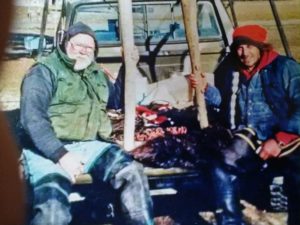 actually rode along with me for a year before he ever put a trap in the ground. He went on to be a pretty darn good trapper. He passed away just a year or so ago. It was always funny because Belin had a big white beard, and white hair, and looked like a seasoned trapper. Whenever we’d go somewhere, the old farmer would come up to us while we were standing at the truck, and even though I had the reputation of being the trapper, they’d always say, “Mr. Jenkins I presume”, and shake Belins hand!
actually rode along with me for a year before he ever put a trap in the ground. He went on to be a pretty darn good trapper. He passed away just a year or so ago. It was always funny because Belin had a big white beard, and white hair, and looked like a seasoned trapper. Whenever we’d go somewhere, the old farmer would come up to us while we were standing at the truck, and even though I had the reputation of being the trapper, they’d always say, “Mr. Jenkins I presume”, and shake Belins hand!
14. Have you ever had a 9-5 job or have you been self-employed your whole life?
I worked commercial fishing boats and shrimp boats for a few years. That’s probably the closest I’ve ever come to a 9-5 job per say. I worked from Virginia all the way up the east coast to the Canadian Maritime on a fishing boat. I worked on shrimp boats from the coast of Georgia to Florida, but no matter what we always made it back to Virginia by January to trap.
15. What was your best year ever for fur?
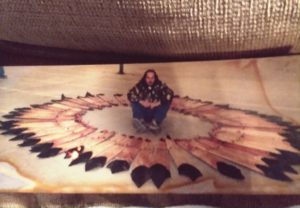 It was definitely the two years that the otter market went crazy. The first year I trapped 101 otter and the next season I trapped 111. Understand this, I was trying to actually avoid beavers, so I started calling them “war possums”. The year I had those 111 otter, I had over 250 beaver. I averaged $135.00 per otter.
It was definitely the two years that the otter market went crazy. The first year I trapped 101 otter and the next season I trapped 111. Understand this, I was trying to actually avoid beavers, so I started calling them “war possums”. The year I had those 111 otter, I had over 250 beaver. I averaged $135.00 per otter.
16. Tell us about your association with the Virgina Trappers Association Bud.
I was skinning muskrats for a guy who was selling fur to another fur buyer, kind of a middle man if you will. Well, when I finished he said stick around, and awhile later, six or eight guys showed up and started talking trapping. I had never even heard about the association back then, and it was small. This was back in the 70’s. They started talking about a convention and I perked my ears up. It sounded interesting and I started going to the meetings. I joined up, helped it grow and watched it grow as well. I was inducted into the Virginia Trapper’s Hall Of Fame in 2014.
17. What’s your favorite setup for beaver and otter?
I would have to say a good channel in the middle of a swamp. Get yourself some old logs for your dive 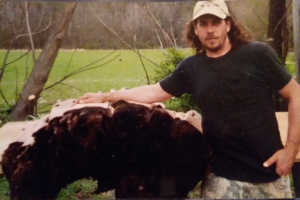 sticks, and blind set em’. I put two conibears at every stop because I know for a fact that there is more than one animal travelling that channel. Whether it be two otter, or an otter and a beaver or an otter or a muskrat. I don’t have enough hours in a day to put one trap at each location. Putting in more than two traps can sometimes get you more animals than you can carry out. I made that mistake years ago. I was beaver trapping company land and I don’t think it had ever been trapped for beaver. I was getting paid to trap these beaver, so I walked back in the swamp with four or five conibears a half mile or so, and set up all the channels and secondary dam crossings. There was sign everywhere. It was like beaver paradise. The next day when I went in, I took four or five more traps. Well, the traps I put out the day before all had something in them alot of them were good sized beaver, 55-60 pounders. I kind of had to hop scotch them critters out of there back to the truck and then my dumb ass went and set more traps. The same thing happened the next day only I had six or eight critters to haul out the next day.
sticks, and blind set em’. I put two conibears at every stop because I know for a fact that there is more than one animal travelling that channel. Whether it be two otter, or an otter and a beaver or an otter or a muskrat. I don’t have enough hours in a day to put one trap at each location. Putting in more than two traps can sometimes get you more animals than you can carry out. I made that mistake years ago. I was beaver trapping company land and I don’t think it had ever been trapped for beaver. I was getting paid to trap these beaver, so I walked back in the swamp with four or five conibears a half mile or so, and set up all the channels and secondary dam crossings. There was sign everywhere. It was like beaver paradise. The next day when I went in, I took four or five more traps. Well, the traps I put out the day before all had something in them alot of them were good sized beaver, 55-60 pounders. I kind of had to hop scotch them critters out of there back to the truck and then my dumb ass went and set more traps. The same thing happened the next day only I had six or eight critters to haul out the next day.
18. What is your favorite cat set?
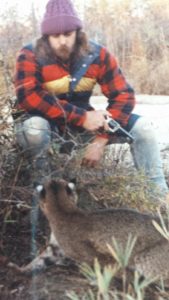 I like to make a big dirt hole set. Bigger than a K-9 hole. Alot of eye appeal. I like to get right on their trail. The key is to not try to lure them too far. If it’s too far off their travel route, they won’t even walk over to look at it.
I like to make a big dirt hole set. Bigger than a K-9 hole. Alot of eye appeal. I like to get right on their trail. The key is to not try to lure them too far. If it’s too far off their travel route, they won’t even walk over to look at it.
19. What is your biggest personal accomplishment to date?
In my whole life? I guess it would be raising two kids that never turned out to be jailbirds! I never had any trouble out of either of them. I was never called to the police station in the middle of the night. My son works on the George W. Bush, and my daughter is in real estate. She’s married and has three kids, and my son just engaged.
20. Did you take the kids on the line with you?
I did take both of them, and they both trapped. While they never had the same love for it that I did, they both learned how to do it, and let me tell you, there were a lot of years that without trapping, Santa Claus would not have brought any presents. I’m one of the only people I know that still relies on fur trapping as a major part of their income. Not so much these past years since the market dropped off, but I’m doing a fair amount of nuisance work now.
21. I’ve heard you’re a big metal dectorist. What year did you start that hobby?
I started this hobby a little later in life. I would say mid 90’s, probably 1995.
22. Tell us about your collection of civil war artifacts.
Well, I had a really great collection at one time, but my house burned down about ten years ago, and I lost the majority of it. I had hundreds of bullets, and after the fire, they were all melted into one big pool of lead. Alot of the stuff was never recovered. I had thousands of Indian artificats. I would scout fur and when I was finished, I would hunt indian artificats.
23. What is your most prized artifact?
I still have my most prized artifacts because I never brought them into the house to have them cleaned up. It’s the trunk of a tree buried in the mud along the riverbank with two canonballs embedded in it. There was a little skirmish down here outside the small town where I live. Some yankee gunboats came up the river and the confederates had dropped some trees in the river to keep them from going any farther. They lay in ambush on the riverbank. They exchanged fire and finally got out of the little trap that had been set for them. Me and another fellow looked for that area for years, and finally found it undiscovered. I know myself I have 20 canonballs from that site alone.
24. What is your oldest artifact?
It would be the Megalodon shark teeth. We live in an area about seventy miles from the coast. We have shell banks that are like prehistoric shell banks. We are talking millions of years old. I found them in the river with hip boots on in the summer. I had a half dozen of them but they were lost in the fire too.
25. I’ve heard you’re a turtle trapper, can you tell us a bit about that?
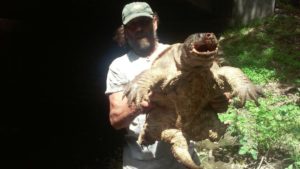 Actually Newt Sterling got me started in it. He came down here and did some commercial turtle trapping, and I saw the potential and bought some traps and started doing it myself.
Actually Newt Sterling got me started in it. He came down here and did some commercial turtle trapping, and I saw the potential and bought some traps and started doing it myself.
26. What’s your biggest turtle you’ve ever caught?
The biggest ones have ranged from 48-50 lbs. That’s a big damn turtle!
27. What do you think the biggest challenge that the trapping industry faces is today?
The trapping industry has to find some kind of market that would provide enough income from harvesting fur to keep people interested in the sport and stay in it, and trap more aggresively instead of doing it as a passing fad or hobby.
28. If you could give advice to a trapper just starting out today Bud what would you tell them?
I would tell them, if that’s what you want to do, you have to realize it’s not going to be easy. First of all, the time of the year you do it is very limited. If you really want to make a go of it you need to develop the mindset that you will have to diversify how you make money by trapping. For instance, nuisance work, live market trapping, or actually guiding people like you would for a big game hunt. Join your organizations, go the meetings, go to conventions, and finally, support the industry that you are a part of.
